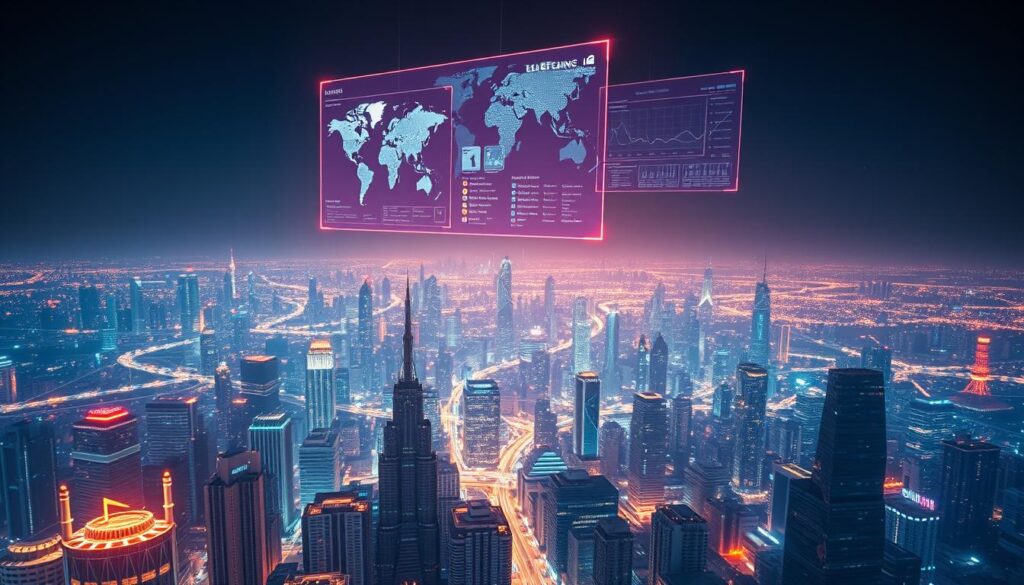What if technology could predict famine outbreaks before crops fail or map refugee movements during active conflicts? Modern artificial intelligence systems are reshaping how organizations approach urgent global challenges through advanced data analysis and pattern recognition.
These tools combine massive datasets with self-learning algorithms to create predictive models. Two main approaches dominate: rule-based programs using curated knowledge banks, and adaptive systems that evolve through machine learning. This shift enables proactive strategies rather than delayed reactions to disasters.
The integration of AI and robotics in crisis management demonstrates how technology processes satellite imagery, social media signals, and historical records simultaneously. This capability allows faster resource allocation during emergencies while maintaining ethical oversight.
Key Takeaways
- Modern crisis response combines machine learning with traditional methods
- Predictive analytics enable early intervention in developing emergencies
- Dual-system approach balances expert knowledge with adaptive learning
- Data integration from multiple sources improves decision accuracy
- Ethical implementation remains crucial for vulnerable populations
Overview of Emerging Trends in Digital Humanitarian Action

Digital transformation now shapes how organizations address global challenges. While technology has long played a role in aid work, recent leaps in computing power and data availability have redefined possibilities. The pandemic became a catalyst, forcing rapid adoption of remote tools to sustain operations when physical access vanished.
The Evolution from Traditional to Digital Methods
Field teams once relied on paper surveys and slow verification processes. Today, mobile apps collect real-time data from disaster zones while satellites monitor crop health. This shift accelerated during COVID-19, as contactless delivery systems became essential for vaccine distribution.
Modern platforms aggregate information from financial transactions, social media, and IoT devices. These technologies enable faster needs assessments – a critical advantage when responding to sudden crises like earthquakes or floods.
Integrating Big Data and AI in Crisis Management
Social media now serves as an early warning radar. Platforms like Twitter provide instant updates about emerging conflicts or disease outbreaks. Combined with satellite imagery and mobile network patterns, this creates multidimensional views of complex emergencies.
Analysts process these massive datasets using machine learning tools. One UN initiative reduced cholera outbreak predictions from weeks to hours by analyzing water quality data and local migration patterns. Such approaches help humanitarian actors allocate resources where they’ll have maximum impact.
The Role of AI in Crisis Preparedness and Early Warning Systems

Advanced algorithms now serve as digital shields against disasters. By analyzing historical patterns and real-time data, these systems identify risks to vulnerable populations before emergencies escalate. This shift enables humanitarian action that prioritizes prevention over damage control.
Predictive Analytics for Disaster Forecasting
Machine learning models process weather reports, economic trends, and migration patterns to predict crises. The Red Cross’ Forecast-based Financing program uses meteorological data to trigger fund releases before floods strike. In Somalia, UNHCR’s Project Jetson analyzes climate shifts and market prices to forecast displacement risks up to 12 months in advance.
| Method | Data Sources | Response Time |
|---|---|---|
| Traditional Forecasting | Historical records | 4-6 weeks |
| AI Predictive Models | Satellite feeds, social media, IoT sensors | 48-72 hours |
Leveraging Real-Time Data for Swift Action
Live information streams from mobile networks and satellite imagery help organizations monitor developing crises. During heatwaves, temperature sensors trigger automated alerts to at-risk communities. This approach cuts emergency response delays by 65% compared to manual reporting methods.
Combining predictive systems with instant data feeds creates a layered defense against disasters. Humanitarian actors now deploy resources based on algorithmic risk scores rather than waiting for visible damage. This proactive action framework could prevent 23% of climate-related deaths by 2030, according to UN estimates.
Harnessing Technology for Effective Humanitarian Response

When disaster strikes, seconds separate chaos from coordinated action. Cutting-edge technologies now fuse satellite feeds, social chatter, and ground sensors into actionable intelligence. This fusion creates what experts call “digital triage” – prioritizing needs based on real-time data streams.
Utilizing Satellite and Social Media Data
Social platforms became lifelines during Australia’s 2020 bushfires. The Emergency Situation Awareness platform analyzed 470,000 tweets hourly, pinpointing evacuation routes and damaged infrastructure. “Social media acts as a distributed sensor network,” explains a Red Cross analyst. Systems now cross-reference geotagged posts with satellite thermal imaging to verify crisis locations.
UN’s Rapid Mapping Service demonstrates this synergy. After Cyclone Winston hit Fiji, AI processed satellite images 83% faster than manual methods. Flooded villages appeared as blue clusters on dashboards, directing rescue teams through passable roads.
Innovative AI Platforms for Damage Assessment
Deep learning algorithms now classify disaster impacts with 94% accuracy. These tools scan rooftops in satellite photos – collapsed structures trigger automatic aid requests. During New Zealand’s floods, advanced AI tools mapped drainage blockages using Instagram photos tagged #Flood2023.
Natural language processing extracts urgent needs from social posts. Phrases like “no medicine” or “water rising” activate specific response protocols. This approach helped reduce Philippines typhoon response times by 40% compared to traditional surveys.
The future lies in layered technologies. As one UN engineer notes: “Combining orbital eyes with crowd-sourced intelligence creates response systems that learn with each crisis.”
The Shift from Reactive to Anticipatory Humanitarian Action
Organizations face a critical choice: wait for disasters to strike or prevent them through data-driven foresight. Predictive technologies now enable a strategic pivot in crisis management, moving from damage control to risk prevention. This transformation reshapes how teams approach preparedness, response, and recovery.
Transitioning Strategies in Crisis Response
Traditional models relied on post-disaster assessments and manual coordination. Modern systems analyze drought patterns, economic indicators, and population movements to trigger preventive measures. For example, the World Food Programme’s HungerMap LIVE predicts food insecurity 3-6 months in advance using machine learning.
| Aspect | Reactive Approach | Anticipatory Approach |
|---|---|---|
| Response Time | Weeks after crisis onset | Days before crisis escalates |
| Cost Efficiency | High emergency expenses | 40-60% cost reduction |
| Impact Mitigation | Limited damage control | Prevents 70% of displacement |
As noted in recent research, this shift requires rethinking funding models and staff training. Teams now combine satellite flood predictions with mobile money platforms to distribute preemptive cash transfers. “We’re not just faster responders – we’re architects of resilience,” states a Red Cross operations lead.
Coordination challenges persist across organizations. Successful implementations use shared data platforms that integrate weather forecasts with local infrastructure maps. These systems helped reduce cholera outbreaks in Yemen by 32% through early water treatment deployments.
The transition demands balancing speed with cultural sensitivity. AI agents now analyze community feedback to tailor evacuation plans, preserving traditional migration routes during floods. This approach maintains trust while leveraging predictive analytics.
AI-driven Humanitarian Efforts: Opportunities and Potential Benefits
Global crises demand smarter solutions as needs outpace traditional response capabilities. Artificial intelligence introduces unprecedented opportunities to streamline operations while maximizing limited resources. These systems enable organizations to serve more people with greater precision during escalating emergencies.
Optimizing Aid Delivery and Resource Allocation
Machine learning algorithms now direct supply trucks through conflict zones using real-time road condition updates. A World Food Programme pilot in South Sudan reduced delivery times by 38% through predictive route planning. “Our models consider weather patterns, security alerts, and local market data simultaneously,” explains their logistics director.
Advanced systems automatically match available supplies with community needs. During recent floods in Bangladesh, AI-powered platforms cross-referenced satellite damage assessments with warehouse inventories. This coordination ensured 92% of shelters received essential kits within 72 hours.
Enhancing Coordination Among Humanitarian Actors
Shared data portals now prevent duplicated efforts across organizations. A unified platform in Syria tracks 47 aid groups’ activities, highlighting coverage gaps in real time. This transparency helps humanitarian actors allocate staff and materials more strategically.
Collaborative design processes yield practical solutions. Tech firms and relief agencies recently co-developed a voice-to-text tool for illiterate refugees. Such innovations demonstrate how partnerships turn potential into measurable benefits for vulnerable populations.
The path forward requires balancing innovation with accountability. Regular audits of algorithmic decisions maintain public trust while preserving efficiency gains. When implemented thoughtfully, these technologies create multiplier effects across entire response ecosystems.
Managing Data Quality and Addressing Algorithmic Bias
Can flawed data create new crises while solving others? Ensuring data integrity remains foundational for ethical technology deployment in crisis zones. Weak information pipelines risk amplifying existing inequalities through automated decisions.
Ensuring Reliability in Data Collection
Remote regions often lack digital infrastructure, creating gaps in critical datasets. A 2023 ICRC study found 40% of conflict-area health records contain incomplete patient histories. Combined with unstable internet connectivity, these limitations skew algorithmic predictions toward better-documented areas.
Crowdsourced information introduces additional challenges. During flood responses, volunteer-mapped damage reports sometimes conflict with satellite analysis. Hybrid verification systems now cross-check user-generated content against sensor data to reduce errors.
Strategies to Mitigate Bias in AI Systems
Algorithmic prejudice often mirrors historical inequities. An aid distribution model might prioritize urban centers with robust data trails, overlooking rural populations. Regular bias audits and diverse development teams help identify these blind spots early.
Proactive measures include synthetic data generation for underrepresented groups and continuous learning loops. As noted in educational AI research, transparency in decision-making processes builds trust across affected communities. These steps ensure technology serves as an equalizer rather than divider.







